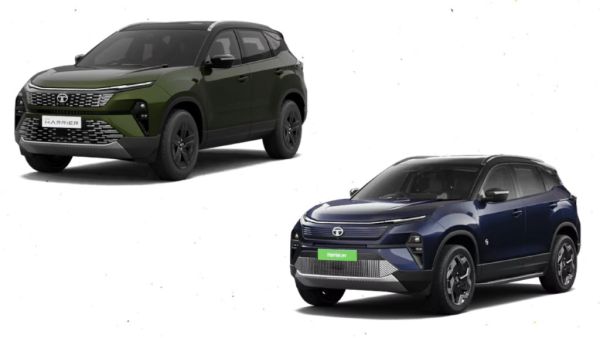
Tata Motors launched the Harrier EV last month at an attractive starting price of Rs 21.49 lakh (exshowroom). One of the key reasons why Tata has been able to price the electric SUV so aggressively is the fact that it isn’t an EV that has been developed from the ground up.
The batterypowered Harrier is based on an updated platform underpinning its fossilfueled namesake and hence many components in the Harrier EV are carried over from its sibling. However, one thing that is completely different is the power source of the two vehicles, one runs on battery and electric motor(s) whereas the other is fueled by diesel and a combustion engine.
Tata Harrier EV vs diesel: Which one’s quicker?
Powering the Harrier EV is a 2.0litre Kryotec turbodiesel engine that kicks out 168 bhp and 350 Nm of peak torque. This engine is paired with either a 6speed manual or a 6speed torque converter automatic. Although the exact acceleration and top speed aren’t available, the diesel Harrier can reach 0100 kmph in around 1112 seconds whereas it can clock 160 kmph easily.

On the other hand, the Harrier EV comes in either a rearwheel drive format or an allwheel drive configuration. The former offers a peak output of 235 bhp and 315 Nm of torque whereas the latter gets an additional 156 bhp from the front motor and 504 Nm of torque. The top speed on both versions is limited to 180 kmph whereas the dualmotor, allwheel drive Harrier EV can sprint from 0 to 100 kmph in 6.3 seconds only.
Therefore, if you’re looking for performance, Harrier EV is hands down the faster of the two.
Tata Harrier EV vs diesel: Which one will go further?
Coming to fuel efficiency, the Harrier diesel claims a fuel efficiency of 16.8 kmpl for both manual and automatic transmissions. In the real world, Harrier is said to deliver a fuel efficiency of around 15 kmpl with a mix of city and highway driving. With a fuel tank capacity of 50 litres, mathematically the Harrier diesel should offer a range of 750km on a full tank.

Whereas, the Harrier EV is offered with two battery options: 65 kWh and 75 kWh. The larger battery pack comes in either singlemotor, RWD configuration or a dualmotor, AWD layout, claiming a range of 627km and 622km, respectively, on full charge. Tata claims a realworld range of between 460 km and 490 km. However, on driving the Harrier EV with the 75 kWh, AWD setup, we received a range of 430 km, which involved offroad driving as well.
Hence, if the priority is to go long, the Harrier diesel is still the one to opt for.
-
Baby Girl Grows Micropenis: Is it true? Here’s what happened when Swedish child came in contact with…

-
Tyrann Mathieu retires from NFL: A look back at his career and legacy

-
Brands bet big on premium products for festive quarter, ramp up output by up to 20%

-
Kristin Cabot House Mortgage: Did Andrew Cabot and wife took out $1.6M mortgage for New Hampshire home? See house property details

-
Tesla’s reputation tanks: Survey ranks it the least-trusted car brand in US - this Japanese brand scores big
